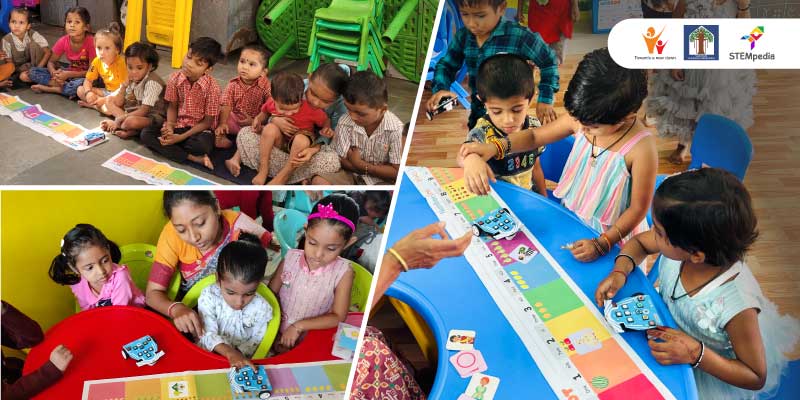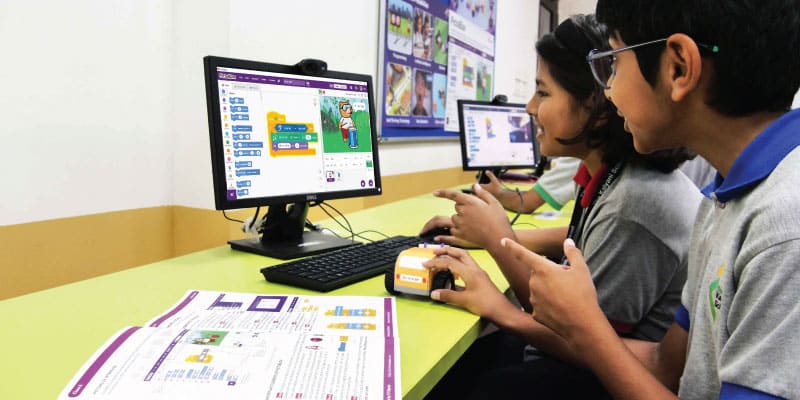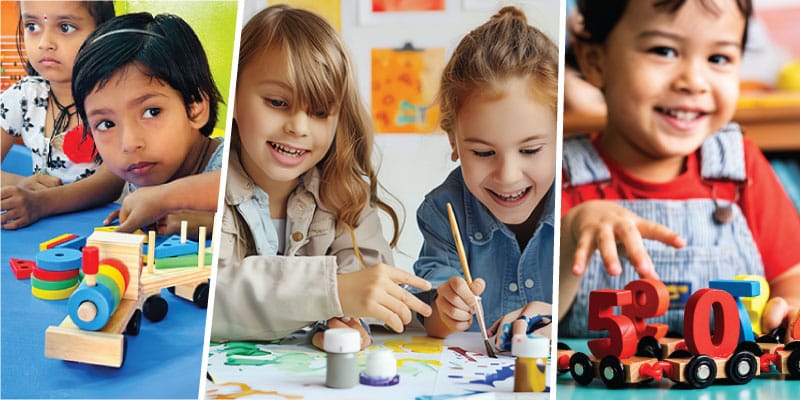What if the first classroom a child enters is filled with imagination, technology, and a sense of purpose? That’s the question driving the transformation of 101 Anganwadis in Vadodara, Gujarat. They are turning traditional early childhood spaces into vibrant, future-ready Smart Anganwadis as the answer.
This flagship initiative, led by the Vadodara Municipal Corporation (VMC) in partnership with STEMpedia, combines play-based learning, toy-based pedagogy, teaching-learning materials (TLMs), and the BaLA (Building as Learning Aid) principles, all aligned with NIPUN Bharat and UNESCO’s ECCE goals.
Transforming Anganwadis into Smart, Child-Friendly Learning Spaces

The Smart Anganwadi project in Vadodara shines as a beacon of what’s possible. This transformation reflects a broader vision from the Ministry of Women and Child Development (WCD), inspired by the 2010 HUNGaMA report, which spotlighted critical gaps in child nutrition and care. In response, WCD launched a major revamp of the ICDS scheme, emphasising early stimulation, joyful learning, and upgraded infrastructure for young children and their communities.
The table below highlights the key achievements and positive changes brought about in early childhood care and education in Vadodara, Gujarat:
| Areas of Impact | Impact |
|---|---|
| Total Anganwadis Transformed | 101 |
| Children Impacted | 5,000+ each year |
| ECCE Goals Addressed | FLN, CT, Nutrition, Inclusion, Health |
| Regional Language Access | Gujarati-first Learning Tools |
| Smart Tools Distributed | 101 Smart TVs, Tablets, Wizbot Kits, AR Flashcards |
Before this initiative, most Anganwadis in Vadodara had plain, worn-out walls, limited learning materials, and minimal child-friendly infrastructure. Through the Smart Anganwadi Project, these spaces reflect child-centric design, blending learning and aesthetics with purpose.
Learning Starts at the Doorstep

The transformation of Vadodara’s Smart Anganwadis begins well before stepping inside. The outer walls have been thoughtfully redesigned and become visual symbols of hope, learning, and joy. Each Anganwadi features a vibrant facade with sun-themed rainbow rays radiating outward, representing the light of education reaching every child. This isn’t just beautification; it’s identity building. The colours reflect early learning themes and signal a safe, stimulating space for the community.
These recognisable exteriors make it easier for parents and children to locate their Anganwadi and feel a sense of pride and belonging. The bright facade acts as a beacon of transformation for under-bridge or isolated locations, signalling that quality education and care exist here, too. Using design as an extension of purpose, the project reimagines external infrastructure as a learning-aligned experience, instantly setting the tone for what lies within.
Walls that Teach: BaLA in Action at Smart Anganwadi
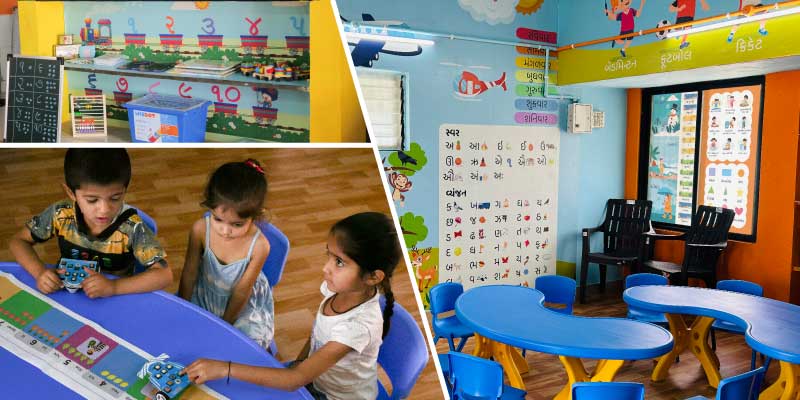
Under the Building as Learning Aid (BaLA) model, walls are no longer passive surfaces — they’ve become vibrant learning tools. Alphabet trains, number lines, and growth charts stretch across colourful walls, while nutrition murals and interactive themes bring real-world concepts to life. Visuals of fruits, animals, and festivals speak directly to a child’s everyday world, blending education with imagination.
Designed for Young Learners for ECCE
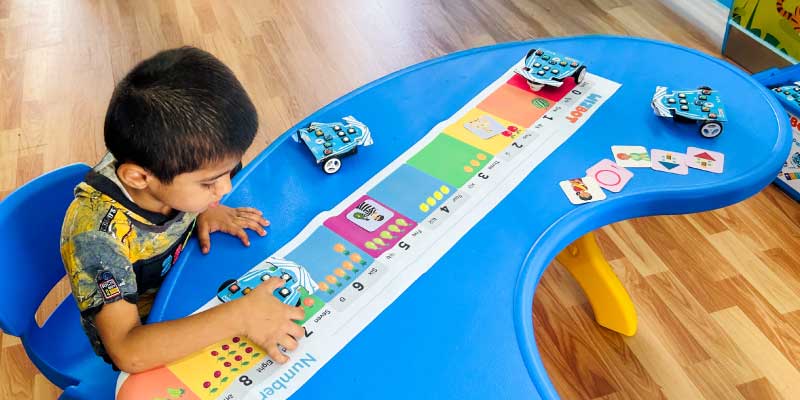
Each center is equipped with child-scaled ergonomic furniture including low tables, soft colorful mats, and modular shelves that children can access independently. Activity corners support various modes of play, including quiet reading, role-play, scribbling, and guided learning. Every space is designed to nurture exploration and agency, encouraging children to move freely and engage with materials at their own pace.
Story-Based Environmental Learning
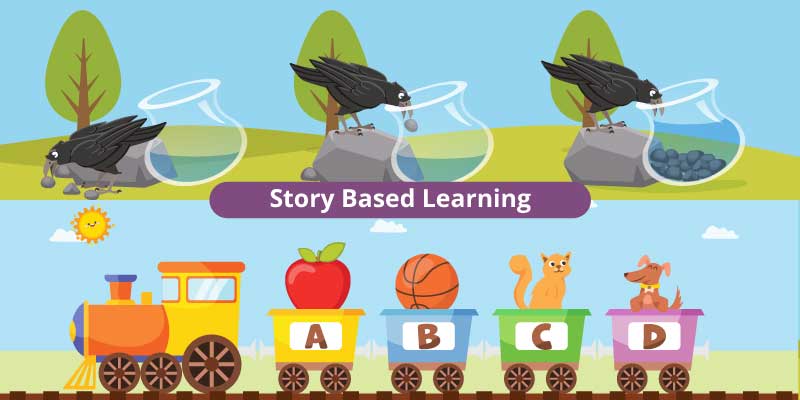
Beyond functionality, the spaces are intentionally designed to be beautiful. Each wall tells a story from the “Maro Aajno Divas Kevo?” reflection panel that supports emotional expression, to the “Letter Land” mural that sparks early language skills. These aesthetic choices aren’t merely decorative; they’re rooted in pedagogy, creating an environment that feels warm, joyful, and full of wonder.
Classroom is the First TLM
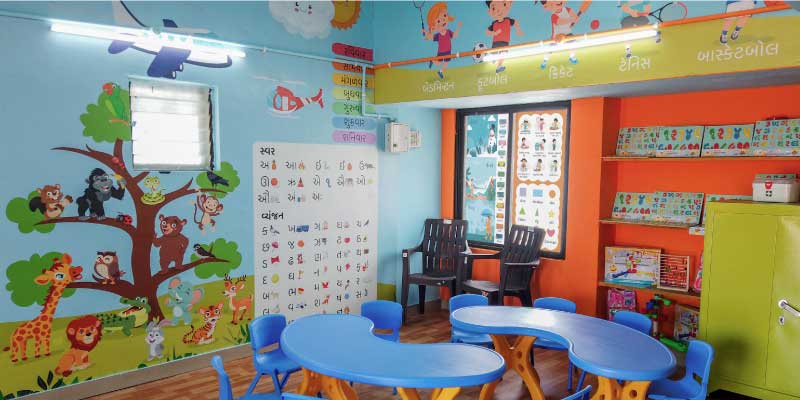
This transformation ensures that the environment itself becomes the first teaching-learning material (TLM). It’s immersive, inclusive, and accessible to all children, inviting them to learn through movement, observation, and interaction. With thoughtful zoning, visual cues, and purposeful layout, each Anganwadi is a living, breathing space of joyful learning.
Smart Learning Tools with Play-based Learning for Early Childhood Care and Education
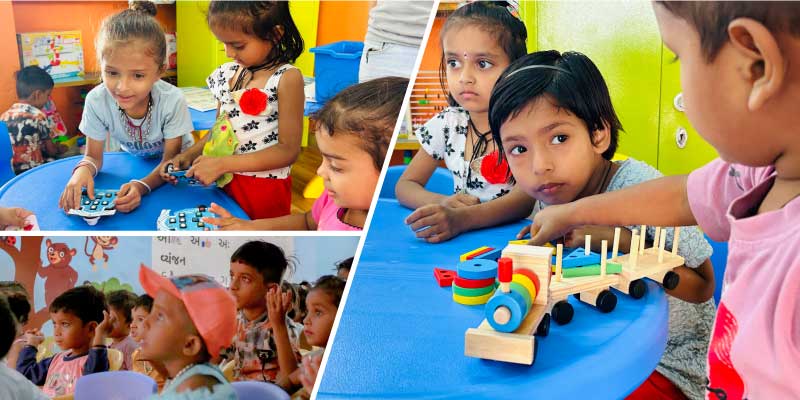
Vadodara’s Smart Anganwadi Project is not just a physical upgrade; it’s a transformation in how early childhood learning happens. We’ve created spaces where curiosity, skill-building, and joy converge through a powerful blend of play-based learning, FLN and CT tools, interactive TLMs, and the Wizbot educational robot.
This approach resonates with the Reggio Emilia philosophy, which views the environment as the “third teacher”, a space that nurtures exploration, collaboration, and expression. It also echoes global best practices from UNESCO and UNICEF, which emphasise that integrated, play-based ECCE during the 0-8 age window is key to brain development, social-emotional health, and lifelong learning.
Most importantly, this transformation supports India’s National Education Policy (NEP) 2020, which identifies Foundational Literacy and Numeracy (FLN) up to grade 3 as “an urgent national mission” and the highest education system priority, while the NIPUN Bharat mission highlights the need for local-language ECCE tools and distributed digital learning to bridge early learning gaps
The policy stresses that without ensuring basic skills by Grade 3, “the rest of this policy will become irrelevant for our students.”
(Source: NEP 2020, Chapter 2, Sections 2.1–2.2)
Read NEP 2020 full document (Page 8)
With this foundation, the Vadodara Smart Anganwadi initiative has been designed in alignment with national and global frameworks. Each tool and teaching method is evidence-based and child-centric, ensuring joyful learning that builds strong educational roots.
Foundational Literacy and Numeracy (FLN) and Computational Thinking (CT) Tools
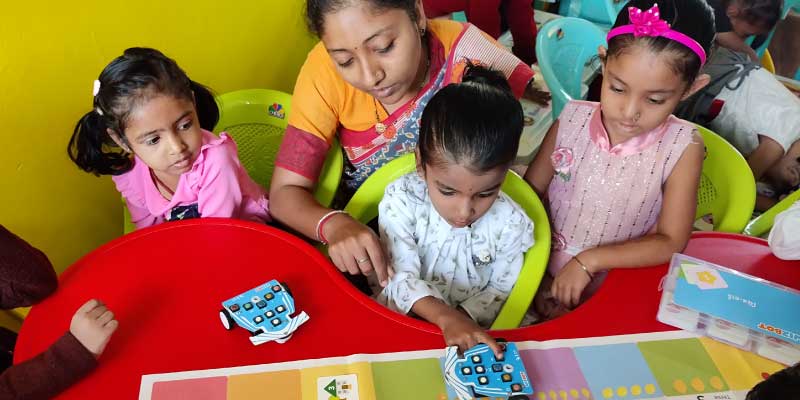
Foundational Literacy and Numeracy (FLN) and Computational Thinking (CT) are at the core of the Smart Anganwadi model. Rather than traditional rote learning, this model uses interactive learning aids, visual tools, and toy-based pedagogy to make early education meaningful, hands-on, and developmentally appropriate.
Visual Aids and Interactive, Daily Learning Panels
Every wall in the Anganwadi now plays an active role in learning.
These BaLA-aligned visual aids are more than decoration, serving as daily TLMs that support emotional, linguistic, and conceptual development:
- “Chalo Ganta Ganta Bhaniye!” invites children to count aloud and learn about time and sequence, reinforcing early numeracy and pattern recognition.
- “Maari Paati and Aaje Kaik Navu Bhanniye!” encourages children to observe and describe their surroundings, improving vocabulary and oral expression.
- Daily Calendars and weatherboards link routine activities to real-world understanding, reinforcing sequencing, time, and observation skills.
On average, at least one guided session using these panels was conducted every single day across all 101 Anganwadis, leading to over 36,000 immersive learning moments annually.
Physical Aids for Literacy and Numeracy
The classrooms are equipped with tactile and hands-on tools that transform abstract concepts into concrete experiences:
- Number trains, abacuses, and number sheets introduce counting, comparing, and sequencing through movement and repetition.
- Alphabet mats and puzzles help with phonemic awareness and letter recognition using tactile, child-friendly formats.
Multilingual book corners like “Mara Vaahla Pustako!” offer engaging picture books in Gujarati and English, developing early reading habits and storytelling skills.
Digital Tools for Language-Rich, Visual Learning
These tools are thoughtfully selected to balance technology exposure with safety, inclusion, and local relevance, all while making learning interactive and joyful.
- Smart LED TVs transform group learning sessions by supporting visual storytelling, phonics practice, number concepts, and daily routines. They bring stories and concepts alive through age-appropriate videos, helping children visualize what they learn and boosting both auditory and visual comprehension.
- Tablets, Pendrives, and Microphones are provided to Asha workers to enable the smooth delivery of modern, multimedia-based pedagogy. These devices support flexible teaching methods, encourage teacher-led content exploration, and are preloaded with curated ECCE content for use at any time.
Gujarati AR Flashcards and Learning Software are standout learning aids that bring everyday animals, objects, and fruits to life using Augmented Reality (AR). Aligned with the NIPUN Bharat mission’s emphasis on mother tongue instruction, these tools strengthen early vocabulary and concept understanding while ensuring cultural and linguistic inclusivity.
Wizbot: The Educational Robot that Sparks Early Brain Development
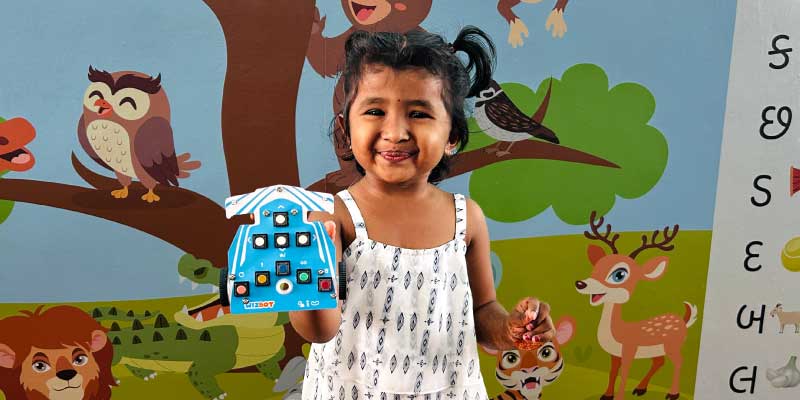
At the heart of tech-enabled learning in Smart Anganwadis is Wizbot, an AI-powered educational robot tailored specifically for young learners. Rooted in the principles of toy-based pedagogy, Wizbot for Anganwadis introduces early concepts of coding, sequencing, and logical reasoning through hands-on, screen-free play.
- Children use button-based commands to move the robot, building simple algorithms and understanding logic through cause-and-effect. Each interaction fosters cognitive development, problem-solving, and spatial awareness, all while keeping the learning joyful and exploratory.
- The Wizbot Classroom Pack (CRP) includes directional grids, activity arenas, storytelling cards, and challenge-based missions. These components transform Wizbot into a comprehensive teaching-learning aid, blending narrative, movement, and tactile engagement to drive foundational learning.
- Wizbot is integrated with a curriculum that’s fully localised in Gujarati, enabling Anganwadi workers to guide structured, play-based activities with ease. From storytelling prompts to challenge cards, every resource is designed to support early learning in the child’s first language, making the introduction to computational thinking both culturally grounded and developmentally appropriate.
Wizbot is more than a device, it’s a playmate, a learning aid, and a child’s first step into logical thinking, laying strong cognitive and creative foundations. Thousands of guided Wizbot sessions have been conducted annually across 101 Smart Anganwadis, enriching the learning experience through daily engagement with computational thinking.
Teaching-Learning Materials: Thoughtful, Inclusive, Purpose-Built
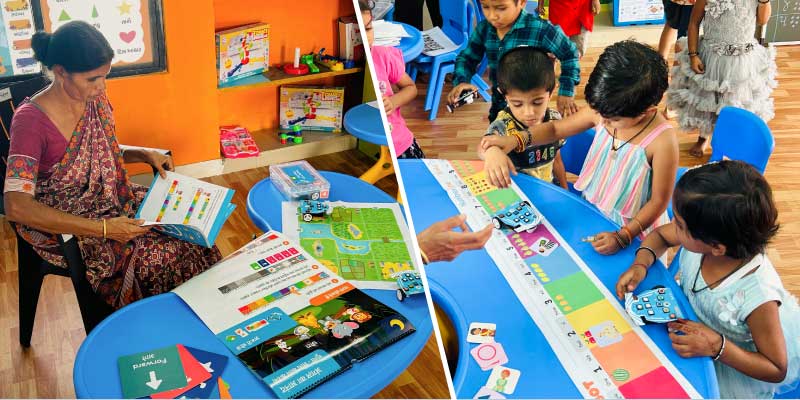
Smart Anganwadis are rich with teaching-learning materials (TLMs) that are interactive, locally relevant, and developmentally appropriate:
- Wizbot CRP Kit TLMs include picture cards, algorithm strips, number and shape missions, story-based movement challenges, and teacher guidance booklets supporting structured yet playful learning.
- Soft sheets, puzzles, educational blocks, and sensory toys promote auditory, visual, and motor development.
- Thematic panels and visual corners act as visual TLMs, covering nutrition, festivals, growth charts, and hygiene in a child-friendly manner.
- Workbooks and learning sheets are designed to complement the tools and build pre-writing, fine motor, and observation skills while reinforcing concepts of letters, numbers, patterns, and sequencing.
Each material is designed not just for learning, but for interaction and joy, making every object in the classroom a tool for thinking, moving, and imagining.
Activities That Make Learning Fun and Purposeful
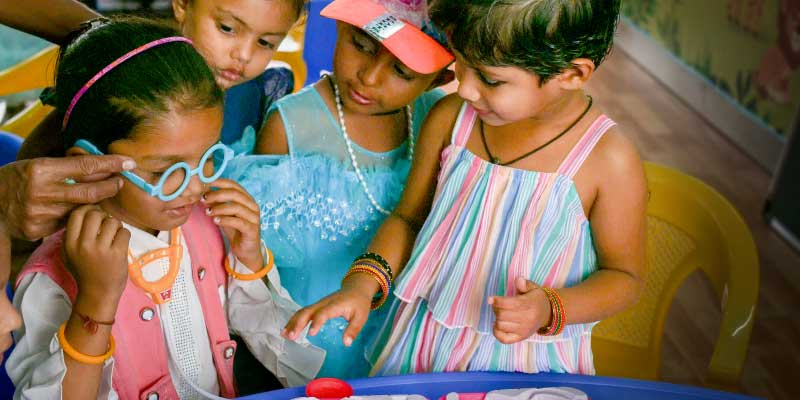
All tools and resources come together in carefully structured activities, created to suit a variety of learning styles and developmental stages:
- Doctor sets and pretend-play kits foster empathy, vocabulary, and imagination, building essential social and emotional skills.
- Pattern games, sorting trays, and logic puzzles encourage analytical thinking and early problem-solving.
- Movement-based activities, such as those using Wizbot or grid-based learning, develop spatial reasoning, body coordination, and curiosity.
Creative tasks, such as storytelling, drawing, and reflection (e.g., through “Maari Paati and Aaje Kaik Navu Bhanniye!” or guided story cards), help children explore their inner world while developing language, observation, and expression skills.
Building Real Skills Through Play
Smart Anganwadis are not just places to learn but spaces where children grow holistically. Every toy, tool, and activity is purposefully designed to build essential cognitive, physical, and social-emotional skills through guided play, storytelling, and movement. This section explores how each skill area is nurtured through hands-on activities using Wizbot and toy-based pedagogy.
Cognitive Skills: Thinking, Understanding, and Reasoning
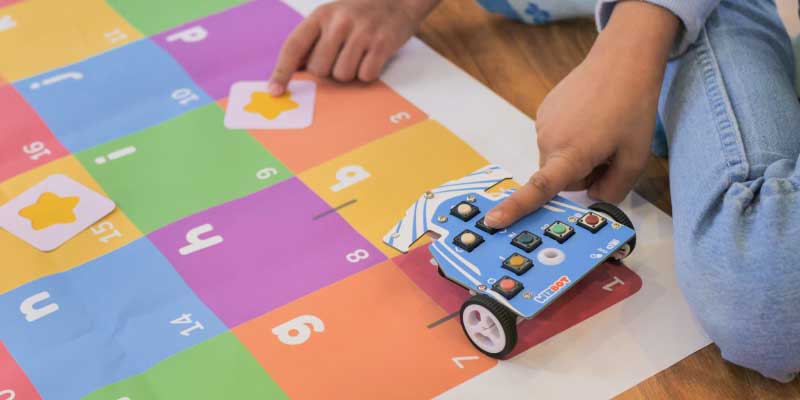
Cognitive development is at the heart of every learning interaction in the Smart Anganwadi program. Through structured play, storytelling, and exploration, children strengthen their ability to think logically, solve problems, and recognise patterns.
- Engaging Activities: The workbook contains 25 engaging activities with creative storytelling that make learning fun for the kids by driving toy-based pedagogy with Wizbot. Listed below are a few sample activities:
- Find the Shape: Children identify shapes and count steps to reach them using Wizbot.
Skills built: Shape recognition, numeracy, sequencing, spatial logic. - Catch the Thief: This fast-paced, gamified activity has children count and move Wizbot to chase a hidden “thief.”
Skills built: Number recall, strategic thinking, and early coding logic. - Left and Right Navigation: Children follow directions to move Wizbot based on animal clues.
Skills built: Directional awareness, auditory processing, comprehension.
- Drawing Mode with Wizbot: Kids use a pen-holder add-on to draw shapes, numbers, and patterns.
Skills built: Logical sequencing, pattern replication, and abstract thinking. - Algorithmic Play: With Wizbot’s button-based commands, children create and execute mini-code playlists.
Skills built: Computational Thinking (CT), algorithm design, task breakdown.
These activities move children away from rote learning and into active, joyful engagement that builds higher-order thinking skills, memory retention, and conceptual clarity.
Motor Skills: Movement, Coordination and Action-Based Learning

Physical development is supported through every push, press, draw, and movement. With tactile learning tools and full-body interaction, children develop fine and gross motor skills that are critical in their early years.
- Wizbot Movement Activities: Children press buttons with precision and follow directional prompts to reach specific grid points.
Skills built: Hand-eye coordination, fine motor control, spatial orientation. - Creative Drawing Mode: As kids draw shapes or letters using Wizbot, they refine grip and directional control.
Skills built: Visual-motor integration, penmanship readiness. - Interactive Panels and Manipulatives: Handling soft sheets, puzzles, and abacuses enhances sensory feedback and muscle memory.
Skills built: Dexterity, bilateral coordination, and focus.
Social-Emotional Skills: Expression, Empathy and Confidence
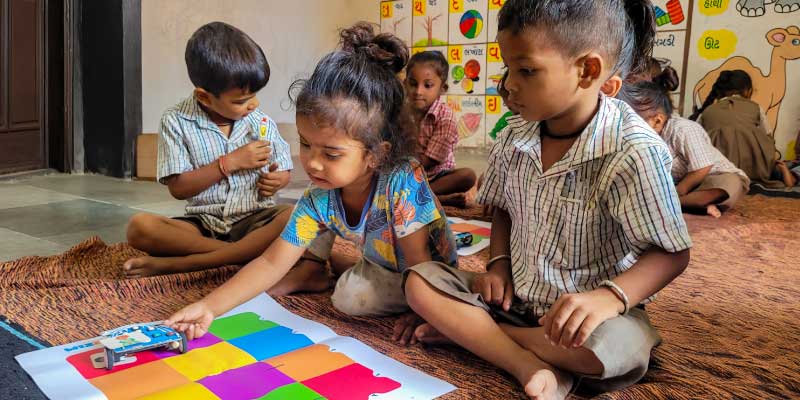
Play is powerful for building emotional intelligence. Smart Anganwadis embed activities encouraging self-awareness, expression, and empathy, helping children relate meaningfully to themselves and others.
- “Hu Shu Bhav Bhaju Chu?” (What am I feeling today?), a reflection panel that helps children identify their emotional state using expressive visuals like faces and weather icons. It promotes emotional vocabulary, mindfulness, and routine-based self-expression in a safe, structured way.
- Role-play toys like Doctor Sets encourage social storytelling and pretend scenarios, building empathy, imagination, and communication.
- Story-Based Wizbot Challenges allow children to create narratives while coding actions, helping them with confidence, collaborative learning, and narrative thinking.
With guided facilitation by teachers and parents, these tools help children feel heard, confident, and safe, forming the base for lifelong emotional well-being.
Empowering ASHA Workers in Anganwadis through Teacher Training Programs

Every successful transformation begins with empowered educators. In the Vadodara Smart Anganwadi Project, Asha workers were not just participants — they became catalysts of change. With structured support, they gained confidence, competence, and creativity in delivering FLN (Foundational Literacy and Numeracy) and CT (Computational Thinking) through play-based pedagogy.
A Three-Phase Training Model for Sustainable Impact
To ensure effective adoption across all Anganwadis, VMC and STEMpedia designed a phased training program, supporting teachers at every level:
- Phase 1: Training the Cluster Coordinators
The journey began with training cluster-level champions — the coordinators. Conducted by expert trainers from STEMpedia, these in-depth sessions oriented leaders across all VMC zones to the goals, pedagogy, and tools of the program. Their role was to mentor and lead implementation on the ground. - Phase 2: Zonal Hands-On Workshops for Asha Workers
Workers from all 19 wards were divided into smaller clusters for interactive, zonal sessions. These workshops weren’t just demonstrations, they were practical, participatory spaces where Asha workers:- Learned to operate smart devices, including Wizbot and tablets.
- Explored how to use TLMs, toy-based learning tools, and digital resources as part of everyday teaching.
- Practiced integrating storytelling, play-based routines, and curriculum-aligned activities into a child’s daily rhythm.
- Gained strategies for aligning toys with FLN and CT goals in an inclusive and engaging manner.
- Phase 3: Ongoing Virtual Support Sessions
In December, a final round of virtual sessions was organised to reinforce learning, solve implementation challenges, and celebrate success stories. This phase focused on confidence-building, ensuring each Asha worker felt supported, guided, and connected even after the initial training was over.
ECCE Beyond Academics: Culture, Environment and Well-Being in Smart Anganwadis

Smart Anganwadis in Vadodara extend learning beyond letters and numbers — they immerse children in India’s rich cultural heritage and instill early respect for nature. These values are seamlessly integrated into the environment, ensuring that children grow with a deep sense of identity and empathy.
- Culturally Rich Displays as Daily TLMs
Walls are not just decorative — they’re storytelling tools. Laminated visuals of local and national festivals, portraits of freedom fighters, and national symbols turn every corner into a moment of civic learning. These displays spark conversations about values, identity, and pride while serving as visual TLMs aligned with a child’s everyday environment. - Growing Environmental Values from the Ground Up
Every Anganwadi features a “Maro Baghicho” (My Garden), a nature corner with gardening kits inviting children to plant seeds, care for plants, and explore the basics of ecological responsibility. It’s a sensory-rich experience that develops patience, curiosity, and a lifelong connection to the natural world.
This embedded cultural and environmental education approach reflects NEP 2020’s call for values-based ECCE. Children don’t just learn about community and sustainability, they live it.
Health, Hygiene, and Safety for Holistic Learning

A healthy child learns better, so every Smart Anganwadi places well-being at the heart of its design and routine. Lessons in hygiene and nutrition are not one-off activities, but part of a structured, daily experience.
As the Ministry of Women and Child Development (WCD) emphasizes, Anganwadis are not just centers for children; they are vital community spaces that foster the health, education, and empowerment of families. This transformation echoes WCD’s vision of integrating health, nutrition, hygiene, and early education under one cohesive model for holistic development.
- Nutrition Awareness
Each center includes a “Maro Health Corner” with engaging posters on nutrition, body awareness, and daily hygiene practices. Children learn how to stay healthy through guided discussions and routine reinforcement, supported by visual aids and real-life demonstrations. - Clean, Safe Learning Spaces
To create child-safe environments, Anganwadis are equipped with Swachhata Kits, first-aid boxes, and easy-to-clean vinyl flooring. Improved ventilation and child-friendly furniture further promote safety and comfort. These elements are not just infrastructural upgrades — they are pedagogical decisions that prioritize student wellness. - Supporting Families, Not Just Children
The transformation has positively impacted thousands of mothers who feel confident sending their children to Anganwadis. Clean, beautiful, and safe environments coupled with a welcoming and structured daily routine have built trust in the ECCE system. Mothers, many of whom juggle work and caregiving, have shared that the Smart Anganwadis feel like an extension of their care.
This balanced focus on physical, mental, and emotional safety ensures that ECCE is not only academically enriching but also nurturing and secure. It lays the foundation for lifelong well-being.
A Scalable Model for ECCE Reform in India’s Anganwadis
Vadodara’s Smart Anganwadi Project is a systemic upgrade to India’s early childhood care and education (ECCE) ecosystem. By thoughtfully integrating the BaLA model, toy-based pedagogy, digital tools, and regional language learning, this initiative showcases how ECCE can be reimagined to meet the needs of the 21st century. This anganwadi is an ideal example for setting up Balvatika, Nandghar, POSHAN 2.0 and Saksham Anganwadi.
This model proves that cost-effective, high-impact upgrades are possible through localised infrastructure, TLMs, and curated technology. Public-private collaboration can reimagine public spaces and empower both children and educators. An ECCE model rooted in Indian values, local languages, and global best practices is not just aspirational but achievable too.
The Vadodara Smart Anganwadi initiative supports foundational learning, creativity, curiosity, and well-being from the ground up. It stands as a replicable, scalable blueprint for governments, NGOs, and education partners across the country.
In a nutshell
From chalkboards to Wizbot, from basic walls to alphabet murals, the transformation of Vadodara’s Anganwadis is a testament to what’s possible when we believe that early learning environments deserve the best of innovation.
We’re not just upgrading classrooms. We’re upgrading childhood.
Explore partnership opportunities or learn how to bring this ECCE model to your state or district.

